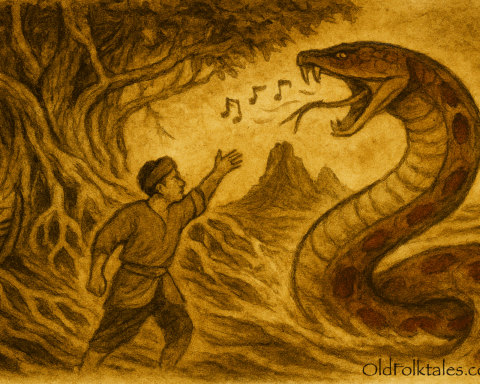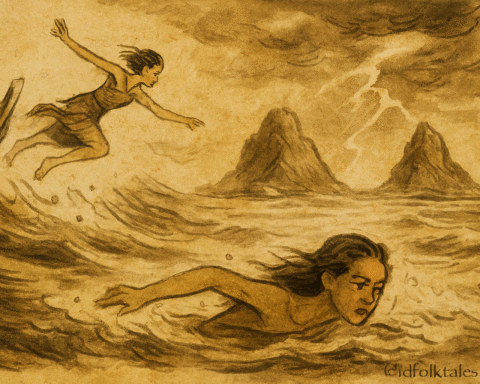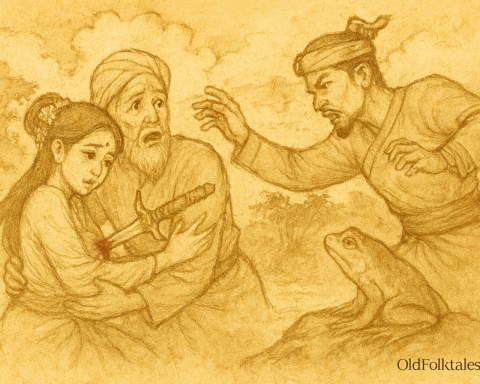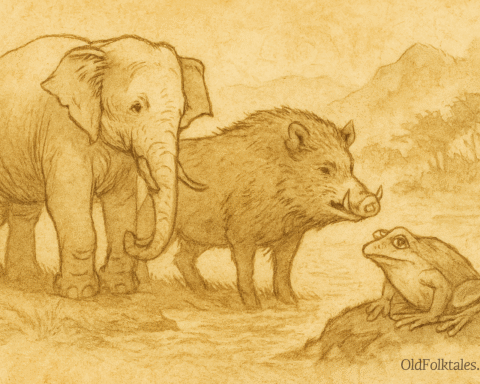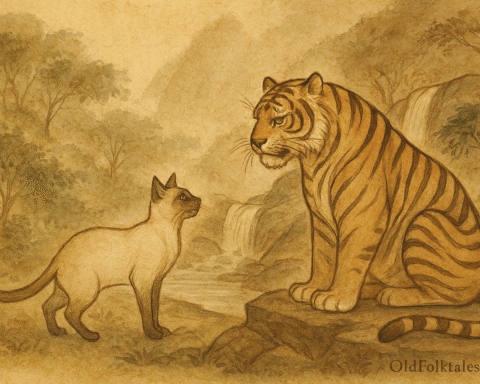In the golden expanse of the African savanna, where the ancient rhythms of life had been followed for countless generations, lived a wise hare and a restless hyena. The season of plenty had arrived, and the fields surrounding their territory were heavy with golden millet, the precious grain that would sustain them through the months ahead. The stalks swayed gently in the warm breeze, their seed heads full and ready for harvest, promising nourishment to those who knew how to prepare them properly.
Both animals understood that possessing the grain was only half the battle, without the proper tools to grind the hard millet seeds into usable flour, their harvest would remain locked away, as useless as stones in their storage places. The task ahead was clear: they needed to craft millstones, the essential tools that would transform their raw grain into life-sustaining food.
The hare, renowned throughout the savanna for his thoughtful nature and skilled paws, approached this crucial task with the reverence it deserved. He understood that a millstone was not merely a tool, but a lifeline that would determine whether he would feast or starve in the seasons to come. With careful deliberation, he selected a perfect piece of hard, durable stone from the rocky outcroppings that dotted the landscape.
For days, the dedicated hare worked with meticulous precision under the scorching African sun. His small but nimble paws moved with the patience of a master craftsman, slowly and methodically carving away excess material. Each strike of his carving tools was purposeful and measured. He paused frequently to run his sensitive paws across the surface, feeling for imperfections, checking the smoothness, and ensuring the perfect roundness that would allow the stone to roll smoothly and grind efficiently.
The hare tested the balance repeatedly, spinning his creation to make certain it would rotate evenly without wobbling. He carved the grinding surface with careful attention to texture, smooth enough to produce fine flour, yet with just enough roughness to grip and crush the hardy millet seeds. When the sun set each day, he would carefully examine his progress, making mental notes of what needed refinement the following morning.
After many days of patient labor, the hare’s masterpiece was complete: a perfectly round, smooth, and strong millstone that gleamed in the sunlight. The tool was a testament to his dedication and skill, every curve and surface reflecting hours of careful work. It sat balanced and true, ready to serve its purpose for many seasons to come.
The hyena, true to her impatient nature, watched the hare’s methodical approach with growing frustration. Her powerful build and naturally aggressive temperament made waiting an unbearable torture. As each day passed and she saw the hare still carefully working on his millstone, her hunger for immediate results grew stronger.
“Why waste so much time on a simple grinding stone?” she grumbled to herself, pacing restlessly in the dust. “I could make one in a fraction of the time and be grinding millet while that foolish hare is still fussing over his!”
Driven by her characteristic impatience and desire for instant gratification, the hyena rushed to find materials for her own millstone. She grabbed the first suitable stone she encountered, paying no attention to its quality or grain structure. With her powerful but clumsy paws, she began hacking away at the stone with reckless abandon.
The hyena worked with fierce intensity but little thought. She carved away large chunks of stone quickly, creating an uneven, lopsided shape that bore little resemblance to the perfect circle that proper milling required. The surface remained rough and inconsistent, with thin spots where she had carved too deeply in her haste and thick, unwieldy areas where she had barely touched the stone.
In her rush to finish, she paid no attention to the structural integrity of her creation. The walls of her millstone were dangerously thin in some places, while remaining unnecessarily thick in others. The grinding surface was pocked with deep gouges and irregular bumps that would make smooth operation impossible.
When both animals finally put their millstones to the test, the difference in craftsmanship became immediately apparent. The hare placed his precious millet seeds into the smooth depression of his perfectly crafted tool. As he began to work, the millstone rolled with effortless precision, its balanced weight and smooth surfaces grinding the hard seeds into fine, usable flour with rhythmic efficiency.
The golden flour that emerged was perfect in texture, fine enough for the most delicate preparations yet substantial enough for hearty sustenance. The hare worked with satisfaction and ease, his millstone performing exactly as intended, transforming his harvest into a bounty of nourishing food that would last through many meals.
The hyena, eager to begin her own food preparation, placed her millet seeds into the irregular depression of her hastily made millstone. From the very first rotation, problems became evident. The uneven shape caused the stone to wobble and catch, making smooth operation impossible. The thin sections she had carelessly carved began to show stress fractures under the pressure of grinding.
With a sharp crack that echoed across the savanna, the hyena’s poorly constructed millstone split apart completely. The thin walls collapsed under the grinding pressure, and the uneven carving had weakened the entire structure beyond repair. Her precious millet seeds scattered across the ground, mixed with fragments of broken stone and rendered completely unusable.
As the dust settled around the remains of her broken tool, the hyena stood empty-handed, her harvest wasted and her hunger growing ever more pressing. From across the clearing, the sound of the hare’s laughter drifted on the warm air. He continued working with his perfect millstone, producing meal after meal of fine flour while openly enjoying the spectacle of the hyena’s failure.
The hyena could only watch in growing hunger and humiliation as the hare enjoyed the fruits of his patient labor, while she faced the prospect of going without food due to her own hasty shortcuts and poor craftsmanship.
The Moral of the Story
This traditional African folktale teaches us that patience, skill, and careful attention to detail are essential for creating lasting success. The hare’s methodical approach and dedication to quality craftsmanship rewarded him with a tool that served him well, while the hyena’s impatience and sloppy work left her with nothing but failure and hunger. The story reminds us that taking shortcuts in important tasks often leads to greater problems later, and that investing time and effort in doing things properly the first time ultimately saves both time and resources.
Knowledge Check
Q1: What materials did the hare and hyena use to make their millstones in this African folktale? A1: Both animals used stone from the rocky outcroppings in their savanna environment. The key difference was that the hare carefully selected high-quality, durable stone while the hyena hastily chose the first stone she found without considering its suitability.
Q2: What does the hare’s smooth millstone symbolize in this traditional African story? A2: The hare’s smooth, strong millstone symbolizes the rewards of patience, skill, and careful craftsmanship. It represents the wisdom of investing time and effort to create quality tools that will serve reliably for many seasons.
Q3: Why did the hyena’s millstone fail in this African folktale? A3: The hyena’s millstone failed because she made it hastily with poor craftsmanship. It was uneven, thin in critical areas, and structurally weak, causing it to break apart under the pressure of grinding millet seeds.
Q4: What is the main lesson taught by this African hare and hyena millstone story? A4: The main lesson is that patience and quality craftsmanship lead to lasting success, while impatience and shortcuts result in failure. The story teaches that proper preparation and attention to detail are essential for creating tools that will serve their purpose effectively.
Q5: How does millet grain function in this traditional African folktale’s plot? A5: Millet serves as both the motivation for creating millstones and the test that reveals the quality of each animal’s work. The grain represents sustenance and survival, making the need for a proper grinding tool essential for transforming raw harvest into usable food.
Q6: What role does the savanna setting play in this African folktale about craftsmanship? A6: The African savanna setting provides the natural environment where both animals must rely on their own skills and tools for survival. The harsh landscape emphasizes the importance of having reliable equipment, as there are no second chances when tools fail in such an environment.


